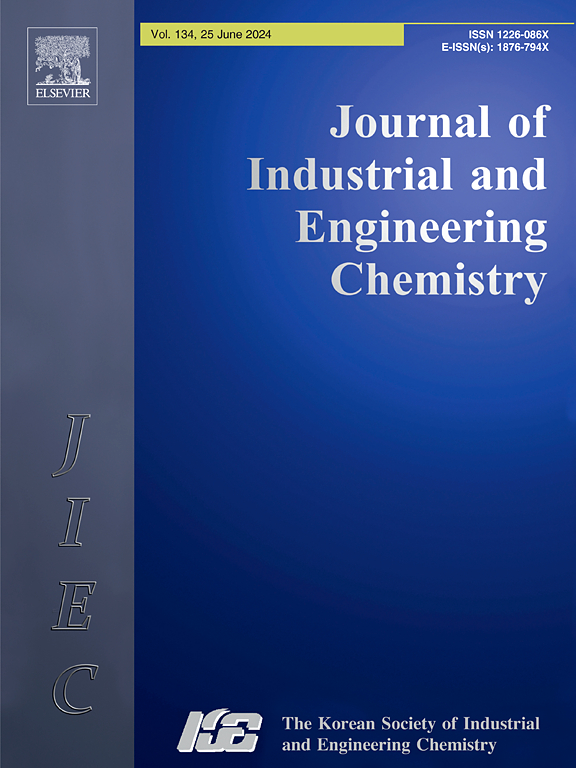Activated LiBH4 and Ni/LiBH4-assisted CO2 hydrogenation to C1, C2 products at low temperature
IF 5.9
3区 工程技术
Q1 CHEMISTRY, MULTIDISCIPLINARY
Journal of Industrial and Engineering Chemistry
Pub Date : 2025-02-22
DOI:10.1016/j.jiec.2025.02.041
引用次数: 0
Abstract
We found that the activated LiBH4 or Ni/LiBH4 can effectively assist CO2 hydrogenation into C1 and C2 products at low temperature (100–300 ℃). After CO2 hydrogenation over the activated LiBH4 or Ni/LiBH4, CH4 with approximately 100 % selectivity was formed in the gas phase products. CH3OH, HCOO−, and high-value CH3CH2OH were observed in aqueous solution of spent LiBH4 or Ni/LiBH4 after CO2 hydrogenation. CO2 conversion and CH4 production are able to be further improved by doping 5–20 wt% Ni into the activated LiBH4. The LiBH4 sample shows a 61.34 % CO2 conversion at 200 ℃, while the 20 %Ni/LiBH4 composite displays an 80.14 % CO2 conversion under the same conditions. The experimental and theoretical results suggest that the synergistic effect from Ni and LiBH4 results in high CO2 conversion at low temperature. This new method for CO2 conversion to C1, C2 products using the activated Ni/LiBH4 composite may enlighten the materials design for CO2 utilization.

活化LiBH4和Ni/LiBH4辅助CO2在低温下加氢生成C1、C2产物
我们发现活化的LiBH4或Ni/LiBH4可以在低温(100-300℃)下有效地辅助CO2加氢生成C1和C2产物。在活化的LiBH4或Ni/LiBH4上进行CO2加氢后,气相产物中形成选择性约为100%的CH4。在CO2加氢后的废LiBH4或Ni/LiBH4水溶液中观察到CH3OH、HCOO−和高值CH3CH2OH。在活化的LiBH4中掺入5-20 wt%的Ni,可以进一步提高CO2转化率和CH4产量。在200℃下,LiBH4样品的CO2转化率为61.34%,而20% Ni/LiBH4复合材料的CO2转化率为80.14%。实验和理论结果表明,Ni和LiBH4的协同作用导致了低温下的高CO2转化率。这种利用活化Ni/LiBH4复合材料将CO2转化为C1、C2产品的新方法,对CO2利用材料的设计有一定的启示。
本文章由计算机程序翻译,如有差异,请以英文原文为准。
求助全文
约1分钟内获得全文
求助全文
来源期刊
CiteScore
10.40
自引率
6.60%
发文量
639
审稿时长
29 days
期刊介绍:
Journal of Industrial and Engineering Chemistry is published monthly in English by the Korean Society of Industrial and Engineering Chemistry. JIEC brings together multidisciplinary interests in one journal and is to disseminate information on all aspects of research and development in industrial and engineering chemistry. Contributions in the form of research articles, short communications, notes and reviews are considered for publication. The editors welcome original contributions that have not been and are not to be published elsewhere. Instruction to authors and a manuscript submissions form are printed at the end of each issue. Bulk reprints of individual articles can be ordered. This publication is partially supported by Korea Research Foundation and the Korean Federation of Science and Technology Societies.

 求助内容:
求助内容: 应助结果提醒方式:
应助结果提醒方式:


